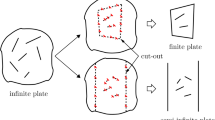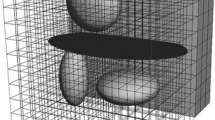Abstract
A procedure is presented which is well suited for three-dimensional subsurface crack identification in a half-space through the inversion of measured surface displacements. The investigation began with the linear, forward problem of generating contour maps of surface deformation produced by a fracture of known geometry and loading which is embedded in a finite medium. The fundamental solutions for tensile and shear multipoles in a half-space provided an efficient mathematical representation of the three-dimensional fracture. The inverse problem of crack identification centers on the development of a hybrid of the Marquardt–Levenberg algorithm. Initial guesses for the constrained set of search variables were determined heuristically from the correspondences between crack geometry and loading and the resulting uplift at the free surface. Physical measurements of surface deformation were taken for a cube of transparent acrylic polyester in which a fracture was hydraulically pressurized. Displacements induced at the surface of the specimen, which were measured by laser interferometry, had a strong correlation with predictions of the computational model (coupled with a finite element discretization). Numerical tests demonstrate the robustness of the inverse methodology even in the presence of the random and systematic errors corresponding to the experimental interferometric measurements.
Similar content being viewed by others
References
Kubo, S. (1988). Inverse problems related to the mechanics and fracture of solids and structures. Japan Society of Mechanical Engineering International Journal Series I 31(2), 157-166.
Mellings, S.C. and Aliabadi, M.H. (1993). Crack identification using inverse analysis. Boundary Elements XV. Computational Mechanics Publications, Boston, pp. 261-273.
Okada, Y. (1985). Surface deformation due to shear and tensile faults in a half-space. Bulletin of the Seismological Society of America 75(4), 1135-1154.
Davis, P.V. (1983). Surface deformation associated with a dipping hydrofracture. Journal of Geophysical Research B 88(7), 5826-5834.
Rongved, (1955). Force interior to one of two joined semi-infinite solids. Proceedings of the Second Midwestern Conference on Solid Mechanics, pp. 1-13.
Keat, W.D. (1989). Surface Integral and Finite Element Hybrid Method for the Analysis of Three Dimensional Fractures. PhD thesis in the Department of Mechanical Engineering, M.I.T.
Keat, W.D., Annigeri, B.S. and Cleary, M.P. (1988). Surface integral and finite element hybrid method for two-and three-dimensional fracture mechanics analysis. International Journal of Fracture 36(1), 35-53.
Dennis Jr. J.E., Gay, D.M. and Welsch, R.E. (1981). An adaptive nonlinear least-squares algorithm. ACM Transactions on Mathematical Software 7(3), 348-368.
Levenberg, K. (1944). A method for the solution of certain nonlinear problems in least-squares. Quarterly of Applied Mathematics 2, 164-168.
Marquardt, D.W. (1963). An algorithm for least-squares estimation of nonlinear parameters. Journal of the Society of Industrial and Applied Mathematics 11(2), 431-441.
Moré, J.J. (1977). The Levenberg-Marquardt algorithm: implementation and theory. Numerical Analysis, (Edited by G.A. Watson), Lecture Notes in Mathematics 630, Springer Verlag, Berlin, pp. 105-116.
Keat, W.D., Erguvan, E. and Dwyer, J.F. (1996). Modeling of 3D mixed-mode fractures near planar bimaterial interfaces using surface integrals. International Journal of Numerical Methods in Engineering 39, 3679-3703.
Author information
Authors and Affiliations
Rights and permissions
About this article
Cite this article
Keat, W.D., Larson, M.C. & Verges, M.A. Inverse method of identification for three-dimensional subsurface cracks in a half-space. International Journal of Fracture 92, 253–286 (1998). https://doi.org/10.1023/A:1007518209688
Issue Date:
DOI: https://doi.org/10.1023/A:1007518209688




